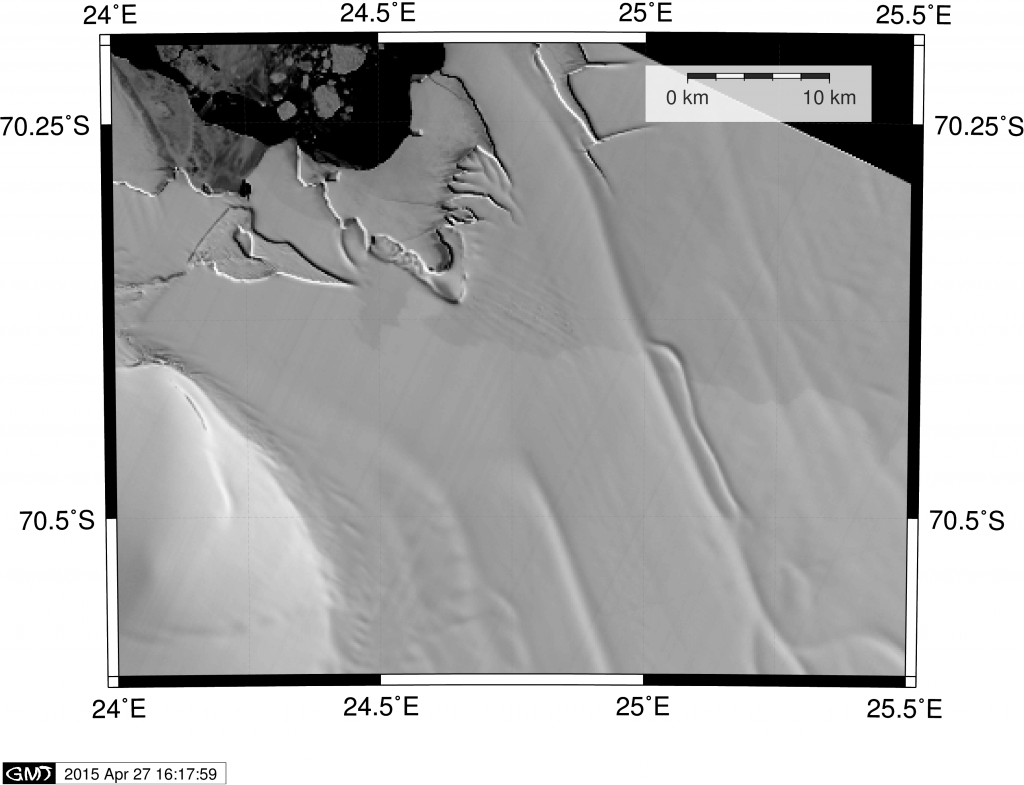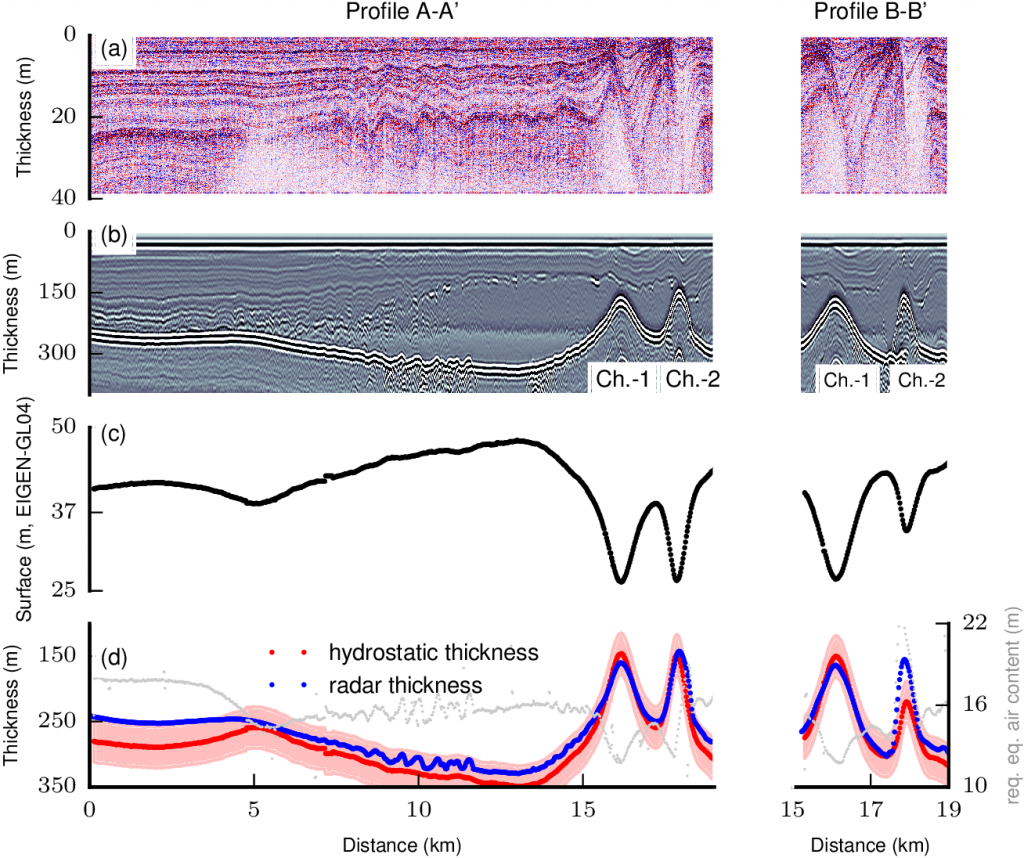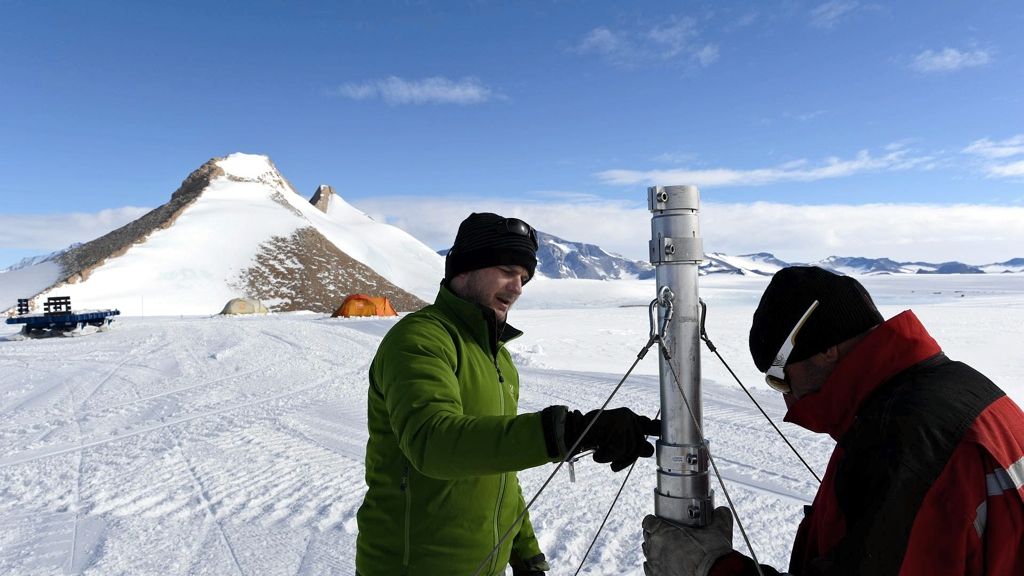Ice shelf channels: important features science is only starting to understand
Penguins frolic at the seaward edge of the King Baudouin Ice Shelf
© International Polar Foundation
In the past few years, scientists have started taking a more in-depth look at curious features that appear on ice shelves in Antarctica: channels. An ice shelf is an extension of ice flowing off the continent, forming a floating platform of ice on top of the water. Many ice shelves contain channels in which ice is significantly thinner than in the surrounding parts of the ice shelf.
The big question that remains to be answered is how much these channels influence the stability of ice shelves. Do they make them more stable or less?
Thanks to the InBev-Baillet Latour Antarctica Fellowship, Université Libre de Bruxelles (ULB) glaciologist Dr Reinhard Drews was able to spend two austral summer seasons (2012-13, 2013-14) on the King Baudouin Ice Shelf in East Antarctica, studying it as part of the ULB's Be:Wise project. During his time there, Dr Drews took the chance to examine the channels in greater detail. In this interview, he explains his findings, which were published recently in The Cryosphere.
What are these channels you’ve been observing on the King Baudoin Ice Shelf? What causes them?
What’s happening at the King Baudouin Ice Shelf - and at many other ice shelves in Antarctica - is that channels in the ice shelf form through melting of the ice shelf from below.
Because the ice is thinner where these channels are, the surface of the ice becomes depressed on the surface, so you can easily see the channels in satellite imagery (see photo on the right).
We glaciologists didn’t know exactly what was going on in these channels for quite some time. But in the past four our five years, a lot of research has been done on them. Research has shown that in the thin channels, basal melting can be significantly enhanced.
How much thinner are the channels compared to the rest of the ice shelf?
When you take radar measurements of the ice shelf at these channels - as we did in our field work - then you can measure how thick these channels are.
The thickness of the King Baudouin Ice Shelf from its surface to its underside, where it touches the sea below, is about 300 metres. However, in one of these channels, the ice shelf is only 150 metres thick - so only half the thickness of the rest of the ice shelf (you can see it in the radar images we took!). That’s a very large difference in ice thickness.
How do these channels form?
In studies that have been done on other ice shelves in Antarctica, scientists have learned that these channels form because melting at the base of the ice shelf is much, much higher inside the channel compared to the rest of the ice shelf.
As the base of an ice shelf touches the ocean, there is constantly an interaction between the ice shelf and the ocean water. Ice can either melt off of the base of the ice shelf, or ocean water can freeze to its base. One of the two processes is happening all the time.
Research has been finding that basal melting can contribute to a significant amount of ice being lost from Antarctica. The amount of ice lost from basal melting is on the same order of magnitude as the amount of ice lost from from icebergs calving off the end of ice shelves, according to recent studies.
Therefore the basal mass balance - how much ice is gained or lost form the bottom of the ice shelf from melt or re-freeze - is a very important factor to consider when looking at the overall ice mass balance in Antarctica (how much ice is being lost or gained from the continent).
So the importance of basal melting of ice shelves has only recently been discovered?
It’s a relatively new understanding that we have these kinds of channels in Antarctic ice shelves. But the key question - a question my colleagues and I are interested in understanding - is how much these channels affect ice shelf stability.
One hypothesis is that basal melting increases the size of the channels so much that it weakens the ice shelf and may eventually contribute to the ice shelf breaking up. However, other studies have shown that if you have enhanced basal melting inside the channels, it can protect the rest of the ice shelf from basal melting. So overall, we don’t yet know whether these channels stabilize or destabilize ice shelves.
But we do know that a lot of ice is melting and/or refreezing over a short amount of time and over very short spatial scales. You can’t study these kind of processes using only satellites. Basal melting is a hidden process. You need to do in-depth on-site data collection.
What did you discover about these channels during the two seasons you conducted research on the King Baudouin Ice Shelf?
We noticed the surface velocities of the ice shelf (the speed at which the surface of the ice shelf flows) is different near these channels. The ice on the surface of the ice shelf is converging into these channels as the ice flows away from the continent.
It was important for us to have ground truth data collected on the ice shelf (radar data, GPS measurements, etc.). This data verified what we were seeing form satellites - that the differences in ice flow velocity were indeed real and likely due to basal melting.
We might even be able to go one step further and look only at surface velocities to figure out whether there’s significant basal melting in the channels.
So it might be possible to tell exactly how much basal melting is happening simply by looking at the surface velocities of the ice?
We can’t quantify the basal melting at the moment simply by looking at the surface velocities. What I did in this study was use an ice flow model. I “created” some generic channels in the ice shelf in the model, and prescribed typical basal melt rates at the base of these channels, and saw how this influenced the velocities of the ice flow at the surface of the ice shelf. The model closely reproduced the observations we made on the ice shelf during our field work, which means that we can see what these processes are doing.
But we glaciologists aren’t at the point yet where we can say that a certain change in surface velocity of the ice shelf means that a certain amount of basal melting is taking place below the ice shelf.
What would you need in order to be able to determine basal melt of the ice shelf via satellite?
When we were in the field, we placed a phase-sensitve ice-penetrating radar in one of these channels on the surface of the ice shelf. This radar is still out there on the ice shelf taking measurements since over four months. Simultaneously two GPS receivers are logging (and Tweeting!) their position every day. We plan to collect those instruments next season and to analyze the data.
The measurements from the radar will give us the basal melt rates inside the channel with very high confidence. We’ll then be able to take this melt rate and compare it with the change in surface velocity of the ice, and see if we can find a correlation.
We won’t be able to give a quantitative analysis of exactly how much basal melt is happening in each of these channels. But since we'll have the melt rates over one entire year, we’ll be able to tell whether there’s a seasonality (more melt occurs during certain times of the year), or if the tides influence basal melting.
But that’s outside the scope of the Be:Wise project. That will have to be for a study yet to come.
Why would this need to be part of a different research project?
When I started the Be:Wise project in 2012, everything was focused on studying the pinning points of ice shelves (points where protruding bedrock slows the flow of ice). I did that research and a study on the findings will come out soon. But seeing the channels when I was in Antarctica led to this "side study" if you will.
I knew the channels were there in the ice shelf, but I’d never grasped their importance. But while we were in the field, I could see the channels with my own eyes. It’s a lot different from seeing them on a satellite image. The channels were quite deep on the surface (we had to drive over them on the skidoos!). So we adapted our data collection programme to include taking profiles of the channels.
How many other ice shelves have been studied as in-depth as the King Baudoin Ice Shelf?
Aside from the King Bauduoin Ice Shelf, the Pine Island Ice Shelf in West Antarctica (which is fed by the Pine Island Glacier) has been studied quite a lot, mostly due to the fact that it has been losing a lot of ice over the past few decades and scientists what to know why it's been losing ice.
But now we see in East Antarctica that we have similar processes going on. This kind of phenomenon is not represented in any kind of global mass balance analysis for the entire Antarctic continent.
There are many other ice shelves with these channels. But very few have been studied. It’s logistically challenging to image these channels in depth. It is our hope one day to be able to find some generic patterns in these channels, because the international glaciological community will never be able to go and visit all the channels.
Using field data that we’ve collected, we hope one day to be able to characterize what’s happening at the bottom of the channels from what we can see on the surface of the ice shelf (surface ice velocities, for example) from satellites.
Will your research contribute to making better estimates of ice mass balance on the ice sheet covering Antarctica?
Yes, it will.
But I think a more critical factor is how these channels affect ice shelf stability. Do they protect ice shelves and strengthen them by concentrating basal melting inside the channels and not anywhere else? Or do the channels weaken ice shelves by making the ice thinner in many places, and eventually lead to their disintegration?
The honest answer is that we don’t know definitively which one it is at the moment. Our study opens the way for characterizing what’s going on in the channels. That’s a very important first step. We need to know what’s going on inside the channels.
The challenge here is that these channels are on a very small scale (comparatively) that we need very high resolution data. Once we have this information, then we might be able to go further, and maybe we'll be able to say that one channel is harming the ice shelf, while another is protecting it - or maybe that all of them are protecting it or harming it.
We still have a lot more work to do to understand what’s happening in these channels!

Rinhard Drews
Reinhard Drews is a postdoctoral researcher at the Glaciology Laboratory at the Université Libre de Bruxelles interested in studying ice flow characteristics in the coastal region of eastern Dronning Maud Land in East Antarctica, where the marine ice sheet is buttressed by numerous ice rises. Dr. Drews was awarded the 2012 InBev-Baillet Latour Antarctic Fellowship to conduct research on the King Baudouin Ice Shelf under the Be:Wise project.






